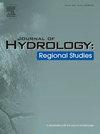The dynamic patterns of groundwater storage in Horqin Sandy Land are driven primarily by climate factors but threatened by human activity
IF 5
2区 地球科学
Q1 WATER RESOURCES
引用次数: 0
Abstract
Study region
Horqin Sandy Land (HQSL), a typical agro-pastoral transition zone in northern China.
Study focus
This study assessed groundwater storage anomaly (GWSA) in HQSL under climate change and human activity, using Gravity Recovery and Climate Experiment (GRACE) satellite data, Global Land Data Assimilation System (GLDAS) models and in-situ well observations. Herein, Mann–Kendall test, Empirical Orthogonal Functions (EOFs) and Partial Least Squares Structural Equation Modeling (PLS-SEM) model were applied to analyze the seasonal and long-term trend changes of GWSA and quantify the process of GWSA in HQSL.
New hydrological insights
HQSL was divided into sandy plain of intensive water use (Zone I) and mountain of water source (Zone II). GWSA from GRACE fitted well with in-situ data (r² = 0.65, p < 0.01). GWSA declined at −0.15 ± 0.12 mm/yr from 1985 to 2002 derived by in-situ observation wells and at −7.79 ± 0.87 mm/yr from 2002 to 2020 evaluated by GRACE. The decline was more pronounced in Zone I (−5.04 ± 0.23 mm/yr) than in Zone II (−3.84 ± 0.18 mm/yr) from 2002 to 2020. Monthly variations peaked in June (−30.78 mm), mitigated by precipitation in August (−8.10 mm) from 2002 to 2020. Spatially, GWSA loss intensified after 2013, particularly in northern mountains. Climate factors consistently influenced GWSA while growing human activity impacts intensified after 2010. These findings provide valuable insights for locals to mitigate climate change impacts through optimization of human activity, as water-saving land use strategies.
科尔沁沙地地下水储量的动态格局主要受气候因素驱动,但也受到人类活动的威胁
研究区科尔沁沙地是中国北方典型的农牧过渡带。利用重力恢复与气候实验(GRACE)卫星数据、全球陆地数据同化系统(GLDAS)模型和现场井观测资料,评估了气候变化和人类活动下HQSL地下水储量异常(GWSA)。本文采用Mann-Kendall检验、经验正交函数(EOFs)和偏最小二乘结构方程建模(PLS-SEM)模型分析了GWSA的季节性和长期趋势变化,量化了HQSL GWSA的过程。shqsl被划分为水资源集约利用的沙质平原(I区)和水源山地(II区)。GRACE的GWSA与原位数据拟合良好(r²= 0.65,p <; 0.01)。根据现场观测井估算,1985 - 2002年GWSA下降幅度为−0.15 ± 0.12 mm/yr, GRACE估算的2002 - 2020年GWSA下降幅度为−7.79 ± 0.87 mm/yr。2002 - 2020年,I区(−5.04 ± 0.23 mm/yr)比II区(−3.84 ± 0.18 mm/yr)下降更明显。2002 - 2020年,月变化在6月达到峰值(−30.78 mm), 8月降水减弱(−8.10 mm)。从空间上看,2013年后GWSA损失加剧,尤其是北部山区。2010年后,气候因子对GWSA的影响持续增强,而人类活动对GWSA的影响增强。这些发现为当地人提供了有价值的见解,可以通过优化人类活动来减轻气候变化的影响,如节水土地利用战略。
本文章由计算机程序翻译,如有差异,请以英文原文为准。
求助全文
约1分钟内获得全文
求助全文
来源期刊

Journal of Hydrology-Regional Studies
Earth and Planetary Sciences-Earth and Planetary Sciences (miscellaneous)
CiteScore
6.70
自引率
8.50%
发文量
284
审稿时长
60 days
期刊介绍:
Journal of Hydrology: Regional Studies publishes original research papers enhancing the science of hydrology and aiming at region-specific problems, past and future conditions, analysis, review and solutions. The journal particularly welcomes research papers that deliver new insights into region-specific hydrological processes and responses to changing conditions, as well as contributions that incorporate interdisciplinarity and translational science.
 求助内容:
求助内容: 应助结果提醒方式:
应助结果提醒方式:


